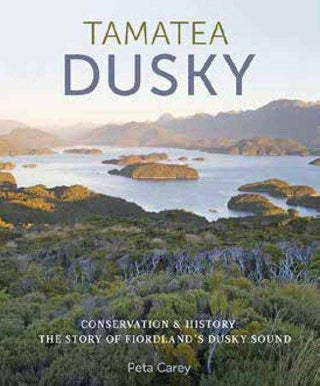Tamatea Dusky : Conservation and History in Fiordland-s Dusky Sound
- Unit price
- / per
-
Author:CAREY Peta
-
ISBN:9781988550190
-
Publication Date:October 2020
-
Edition:1
-
Pages:260
-
Binding:Hardback
-
Publisher:Potton and Burton
-
Country of Publication:


A Back Order button means that we don’t have the book in stock at our store. It may already be on order – or we can order it for you from a publisher or distributor at no additional cost.
As we source items from around the globe, a back-order can take anywhere from 5 days to several weeks to arrive, depending on the title.
To check how long this might take, you’re welcome to contact us and we can provide an ETA or any other information you need. We recommend checking the timeframe before committing to an online order.
Tamatea Dusky : Conservation and History in Fiordland-s Dusky Sound
- Unit price
- / per
-
Author:CAREY Peta
-
ISBN:9781988550190
-
Publication Date:October 2020
-
Edition:1
-
Pages:260
-
Binding:Hardback
-
Publisher:Potton and Burton
-
Country of Publication:
Description
Tamatea/Dusky Sound, in the southwestern corner of Fiordland National Park, contains a magnificent archipelago of over 700 islands.It has a fascinating history, both Maori and European, but best known for being the place where Captain James Cook and the Resolution crew spent six weeks in 1773.Arguably, it is the conservation story that is its most compelling and enduring, for this is where nature conservation began in New Zealand over 120 years ago, and where much of our ground-breaking work in predator control and species conservation has taken place over the last 50 years. Today, the greater Tamatea/ Dusky Sound is the focus of one of the most significant and ambitious conservation and restoration projects inthe world, as populations of such birds as kakapo, kiwi, tieke/saddleback and rock wren are protected and re-established.
Tamatea/Dusky journeys through todays extensive restoration efforts, from the many islands to the mainland and mountains, while charting the extraordinary episodes of human endeavour that have taken place over the last 250 years in this remote, yet spectacular, corner of the New Zealand wilderness.
Adding product to your cart
You may also like
A Back Order button means that we don’t have the book in stock at our store. It may already be on order – or we can order it for you from a publisher or distributor at no additional cost.
As we source items from around the globe, a back-order can take anywhere from 5 days to several weeks to arrive, depending on the title.
To check how long this might take, you’re welcome to contact us and we can provide an ETA or any other information you need. We recommend checking the timeframe before committing to an online order.
You may also like
You may also like
-
Tamatea/Dusky Sound, in the southwestern corner of Fiordland National Park, contains a magnificent archipelago of over 700 islands.It has a fascinating history, both Maori and European, but best known for being the place where Captain James Cook and the Resolution crew spent six weeks in 1773.Arguably, it is the conservation story that is its most compelling and enduring, for this is where nature conservation began in New Zealand over 120 years ago, and where much of our ground-breaking work in predator control and species conservation has taken place over the last 50 years. Today, the greater Tamatea/ Dusky Sound is the focus of one of the most significant and ambitious conservation and restoration projects inthe world, as populations of such birds as kakapo, kiwi, tieke/saddleback and rock wren are protected and re-established.
Tamatea/Dusky journeys through todays extensive restoration efforts, from the many islands to the mainland and mountains, while charting the extraordinary episodes of human endeavour that have taken place over the last 250 years in this remote, yet spectacular, corner of the New Zealand wilderness.
-
-
Author: CAREY PetaISBN: 9781988550190Publication Date: October 2020Edition: 1Pages: 260Binding: HardbackPublisher: Potton and BurtonCountry of Publication:
Tamatea/Dusky Sound, in the southwestern corner of Fiordland National Park, contains a magnificent archipelago of over 700 islands.It has a fascinating history, both Maori and European, but best known for being the place where Captain James Cook and the Resolution crew spent six weeks in 1773.Arguably, it is the conservation story that is its most compelling and enduring, for this is where nature conservation began in New Zealand over 120 years ago, and where much of our ground-breaking work in predator control and species conservation has taken place over the last 50 years. Today, the greater Tamatea/ Dusky Sound is the focus of one of the most significant and ambitious conservation and restoration projects inthe world, as populations of such birds as kakapo, kiwi, tieke/saddleback and rock wren are protected and re-established.
Tamatea/Dusky journeys through todays extensive restoration efforts, from the many islands to the mainland and mountains, while charting the extraordinary episodes of human endeavour that have taken place over the last 250 years in this remote, yet spectacular, corner of the New Zealand wilderness.
-
Author: CAREY PetaISBN: 9781988550190Publication Date: October 2020Edition: 1Pages: 260Binding: HardbackPublisher: Potton and BurtonCountry of Publication:
-



